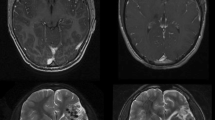Abstract
Treatment of arteriovenous malformations (AVM) of the brain is challenging due to the size and location of the nidus-proper and its proximity to the cerebrovascular circulation. Recent advances in catheter techniques and new embolization materials such as Onyx (a liquid agent that is less adhesive and slowly polymerizing) have increased the probability of achieving obliteration. When planning radiosurgical cases following such embolization, however, one must be cognizant of the distortions introduced by this novel substance on imaging studies. A sample of Onyx was irradiated to define the attenuation per mm thickness. The difference in attenuation compared to water was determined. Dose calculations were performed using 3 methods of inhomogeneity corrections. Homogeneous calculations were compared to “standard” heterogeneity corrections and to “modified” heterogeneity corrections by assigning individual electron densities to the normal brain and the Onyx. The difference between the attenuation of water in comparison to the Onyx was approximately 3% for beam energy of 6 MV. Best calculation results were achieved when using the modified inhomogeneity corrections which were based on the actual attenuation of the Onyx. The use of Onyx caused significant image artifact on MR and especially CT. As such, a correction must be manually introduced into the planning system to account for this potential error. Otherwise, dose calculation may be unreliable and could have dire consequences for patients receiving high doses of radiotherapy.





Similar content being viewed by others
References
Al-Shahi R, Fang JS, Lewis SC, Warlow CP (2002) Prevalence of adults with brain arteriovenous malformations: a community based study in Scotland using capture-recapture analysis. J Neurol Neurosurg Psychiatry 73:547–551
Brown RD Jr, Wiebers DO, Torner JC, O’Fallon WM (1996) Incidence and prevalence of intracranial vascular malformations in Olmsted County, Minnesota, 1965 to 1992. Neurology 46:949–952
Miller CE, Quayyum Z, McNamee P et al (2009) Economic burden of intracranial vascular malformations in adults: prospective population-based study. Stroke 40:1973–1979
ApSimon HT, Reef H, Phadke RV, Popovic EA (2002) A population-based study of brain arteriovenous malformation: long-term treatment outcomes. Stroke 33:2794–2800
Crawford PM, West CR, Chadwick DW, Shaw MD (1986) Arteriovenous malformations of the brain: natural history in unoperated patients. J Neurol Neurosurg Psychiatry 49:1–10
Ondra SL, Troupp H, George ED, Schwab K (1990) The natural history of symptomatic arteriovenous malformations of the brain: a 24-year follow-up assessment. J Neurosurg 73:387–391
Ayad M, Eskioglu E, Mericle RA (2006) Onyx: a unique neuroembolic agent. Expert Rev Med Devices 3:705–715
Weber W, Kis B, Siekman R, Jans P, Laumer R, Kuhme D (2007) Preoperative embolization of intracranial arteriovenous malformations with Onyx. Neurosurgery 61:244–252
Weber W, Kis B, Siekmann R, Kuehne D (2007) Endovascular treatment of intracranial AVM with onyx: technical aspects. AJNR 28:371–377
Natarajan SK, Ghodke B, Britz GW et al (2008) Multimodality treatment of brain arteriovenous malformations with microsurgery after embolization with onyx: single-center experience and technical nuances. Neurosurgery 62(6):1213–1225
Van Rooij WJ, Sluzewski M, Beute GN (2007) Brain AVM embolization with Onyx. AJNR 28:172–177
Cronqvist M, Wirestam R, Ramgren B et al (2006) Endovascular intracerebral AVM: procedural safety, complications, and results evaluated by MR imaging, including diffusion and perfusion imaging. AJNR 27:162–176
Murugesan C, Saravanan S, Rajkumar J et al (2008) Severe pulmonary edema following therapeutic embolization with Onyx for cerebral AVM. Neuroradiology 50:439–442
Loy DN, Rich KM, Simpson J, Dorward I, Santanam L, Derdeyn CP (2009) Time of flight magnetic resonance angiography imaging of a residual AVM nidus after Onyx embolization for stereotactic radiosurgery planning. Neurosurg Focus 26(5):E13
Pollock BE, Flickinger JC (2008) Modification of radiosurgery-based AVM grading system. Neurosurgery 63:239–243
Dietrich S, Pawlicki T (2008) Cyberknife image-guided delivery and quality assurance. Int J Radiat Oncol Biol Phys 71:S126–S130
Author information
Authors and Affiliations
Corresponding author
Additional information
Dr. Kanner and Dr. Corn contributed equally to this work as senior authors.
Rights and permissions
About this article
Cite this article
Shtraus, N., Schifter, D., Corn, B.W. et al. Radiosurgical treatment planning of AVM following embolization with Onyx: possible dosage error in treatment planning can be averted. J Neurooncol 98, 271–276 (2010). https://doi.org/10.1007/s11060-010-0177-x
Received:
Accepted:
Published:
Issue Date:
DOI: https://doi.org/10.1007/s11060-010-0177-x




